Sea scallops are one of my favorite foods. When I first got my sous-vide appliance over two years ago, it was one of the first foods I tried. And I was underwhelmed. I didn’t do any side by side testing back then, but I was pretty sure that I couldn’t find anything special about the scallops that had been cooked sous-vide. After that I didn’t sous-vide scallops anymore. Since I was still relatively new to sous-vide back then, I decided to do a proper side by side experiment to find out once and for all whether those rave reviews I had seen elsewhere about the magnificent texture of sous-vide scallops were true after all.
When I did some experiments with different qualities of scallops, I noticed that the texture of freshly shucked scallops is much firmer than scallops that are sold already shucked. Since I don’t remember having tried freshly shucked scallops in my earlier experiments, I decided to include some fresh ones too. Here’s what I did.
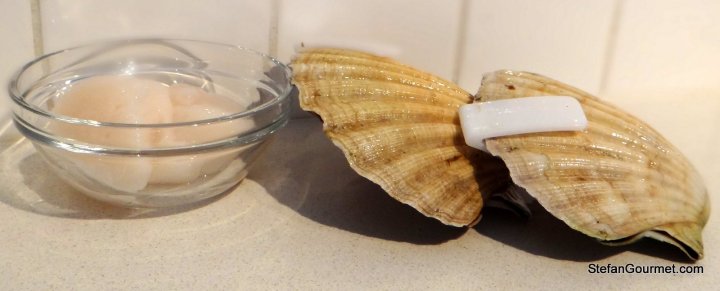
I started with 2 scallops out of the shell with a production date (i.e. shucking date) of 4 days prior, and two scallops in the shell.
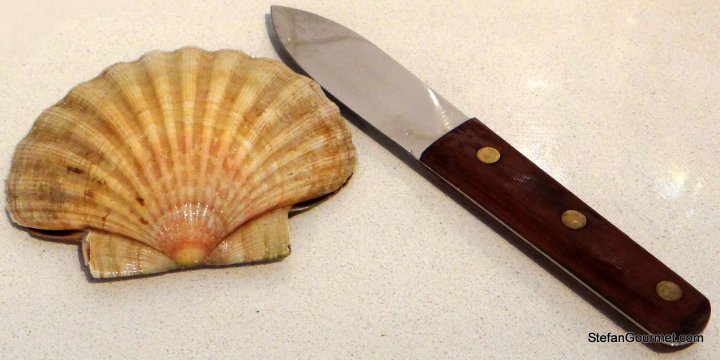
It’s always nice to buy scallops in the shell, because that means I get to use my French knife whose sole purpose is shucking scallops.
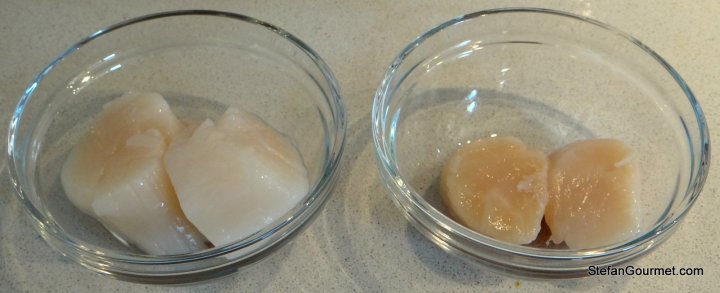
The scallops I shucked myself are on the right. As you can see they have a darker color and are smaller than the ones I bought already shucked.
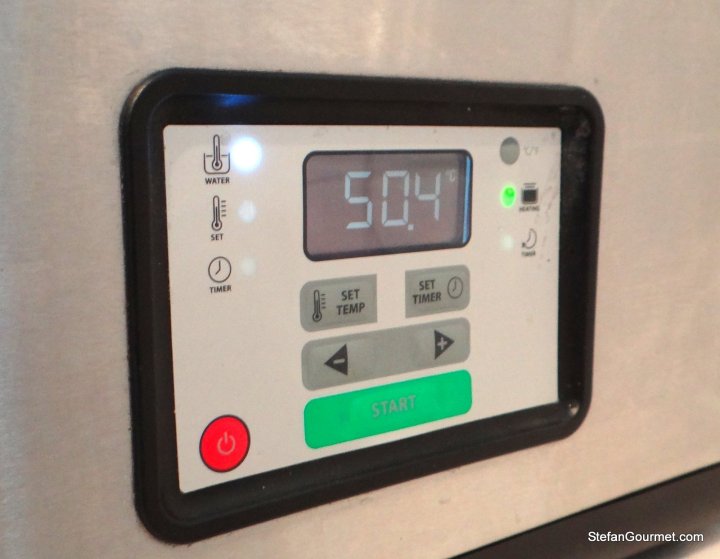
I cooked them sous-vide at 50C/122F for 30 minutes.
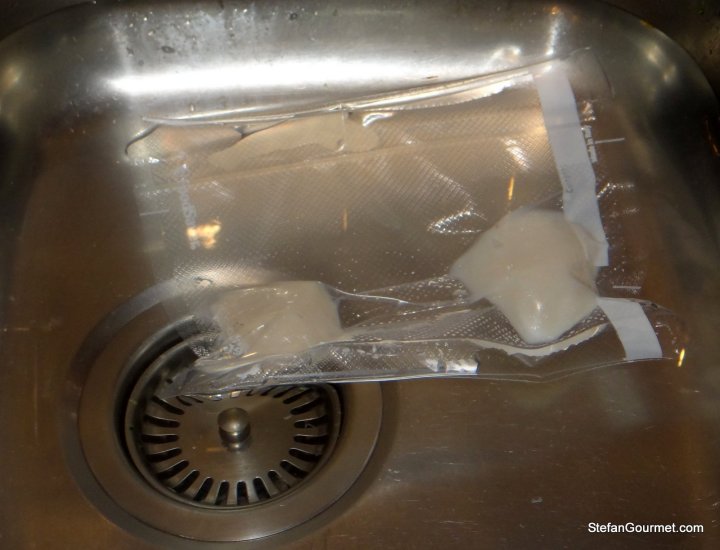
Then I cooled them down quickly.
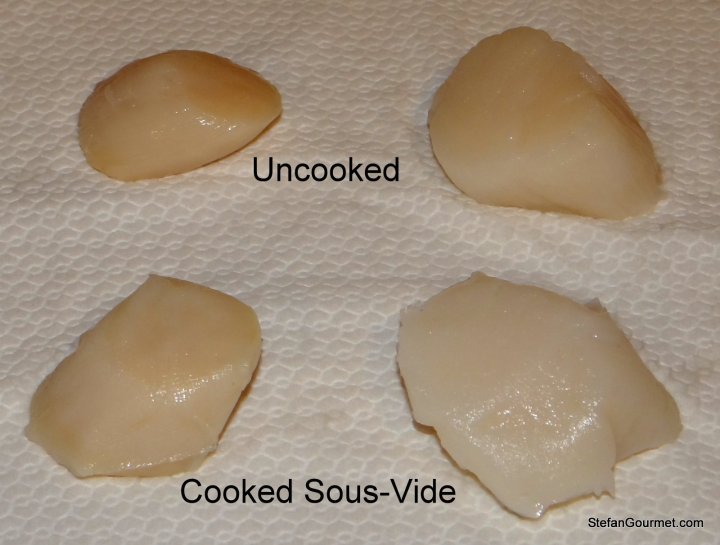
All the scallops were brought to room temperature and patted dry with paper towels. At this stage it was clearly visible which scallops were uncooked and which were cooked sous-vide.

I then melted some clarified butter in a non-stick pan over high heat and added the scallops.
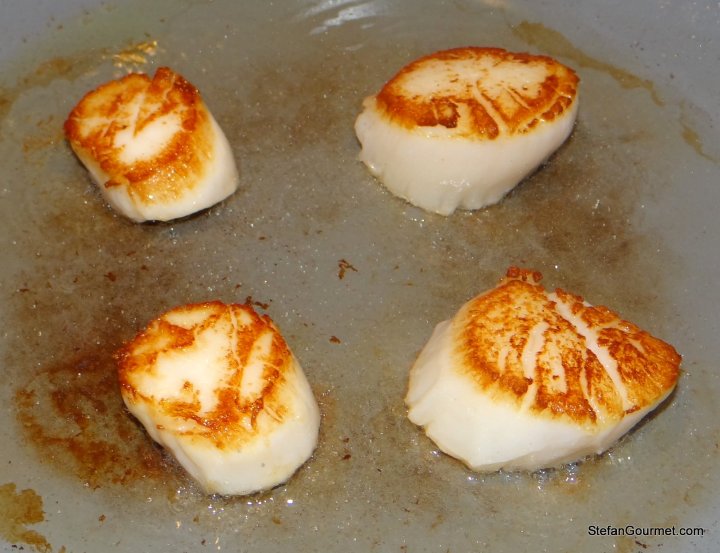
I seared them quickly on both sides. It turned out that I should have seared the smaller freshly shucked scallops even shorter, because they ended up being slightly overcooked.
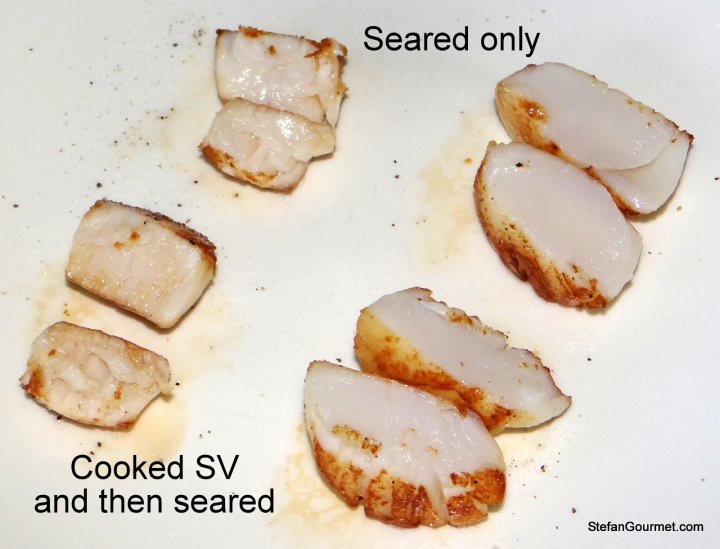
I then tasted all of them. There was no significant visible difference and no difference in texture or taste between the scallops that were seared only and the ones that were cooked sous-vide first. It was as if they had not been precooked at all! Of course there was a difference between the smaller freshly shucked scallops and the larger already shucked ones, but that’s not what this test is about. There was such a lack of difference that I don’t think it worth to perform experiments at different sous-vide temperatures, but I’d be happy to hear about it if anyone has a different experience.
So my conclusion is that there is no use to cooking scallops sous-vide. Just sear them!
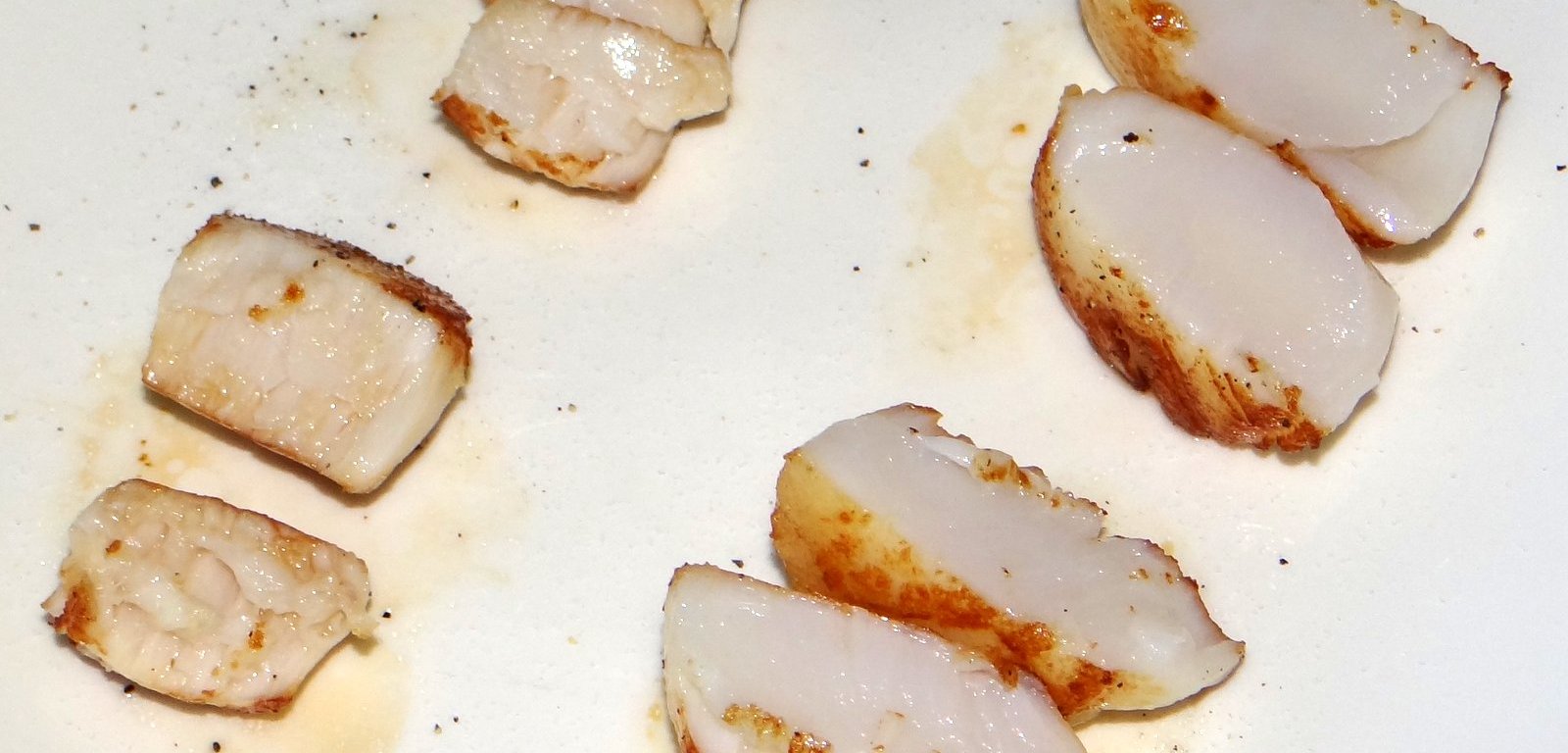
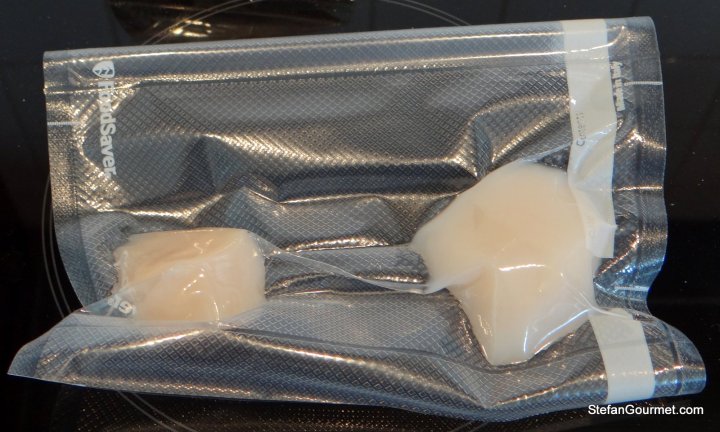

This is so good to know! Great experiment!
LikeLike
Thanks Mimi 🙂
LikeLike
Sorry to disagree with you Stephan (not disrespectfully, of course…) but try the Scallops sous vide @ 55c for 12 minutes then sear quickly – beautiful and, for me, better than simply pan-frying. Give them a go…
LikeLike
Sorry ‘Stefan’; I should have gone to Specsaver…
LikeLike
Hmmm interesting. All the sources I’ve found say 50C. Thanks for the tip, I’ll try 55C next time I have scallops!
LikeLike
I really enjoy your food experiments. This is great information. Thank you.
I had dinner at a wonderful Italian restaurant last night and one dish reminded me of your sous-vide cooking skills. They served for the second course a dish described as: cuttlefish “tagliatelle” with capers, chili flakes, lobster, and agretti. They said that the cuttlefish was cooked sous-vide for 4.5 hours. Then it was pressed to remove any liquids, and then thinly shaved like tagliatelle and then dressed in a wonderful sauce. It was topped with thinly sliced Italian sea grass. I think they said Italian sea grass. Anyway, it was wonderful.
LikeLike
That does sound wonderful indeed, thanks for sharing!
LikeLike
Scallops cook so quickly when seared in the pan, it’s hard to see why you would add an extra cooking process, but I think you concluded that already. 😉 Love your kitchen/lab tests!
LikeLike
They certainly cook quickly — that’s why the small ones went over. Great to hear you like it!
LikeLike
love the side by side comparison tests you’ve been posting. Really informative and fun to read. Thanks Stefan! I too love scallops. I have to say I’ve never shucked my own yet!
LikeLike
You could get yourself into a loop of experimentation, trying them at different temperatures and with different cooking methods (smoking, searing, baking). For me, it’s a very hot pan, sear both sides and enjoy.
LikeLike
That’s how I prepare them 80% of the time, and this experiment confirms it’s the best way. The smoking is nice, but doesn’t let the scallops themselves shine as much.
LikeLike
I applaud your testing, Stefan, but what really caught my eye were scallops so fresh that they’re still in the shell. I’m far too inland to find any here, although I did have one in a marine aquarium once. 🙂
LikeLike
Unfortunately, still being in the shell is not a guarantee for being fresh. But as the weight and space of the shells is so large, it makes sense to shuck them before sending them inland.
LikeLike
I love seared scallops! I have yet to find fresh scallops, but maybe I am not looking in the right places!
LikeLike
I believe they are produced in Massachusetts and Maine. I’m not sure they’re ever shipped in the shell from there.
LikeLike
Hey everyone,
I’ve been studying and experimenting with “modern” cooking techniques. I believe, depending on the quality, scallops can be eaten raw, so pasteurization shouldn’t be an issue. I haven’t played around with scallops yet but my approach would be this:
Cold smoke with maybe alder, oak or pecan for 30-60 minutes.
Sear using a blow torch using MAPP fuel. It’s super quick without over cooking and you can see the color develop. Make sure the flame is blue before you apply it or it may taste like fuel. MAPP is less prone to this than propane or butane.
LikeLike
Hi Aaron, thanks for visiting and taking the time to comment. Blow torches that use MAPP fuel are not available in Europe, but butane seems to do the trick as well. However, I am not sure that in the recipe that you describe a hot skillet won’t work as well?
LikeLike
You are correct, the skillet does work fine. I like the torch approach because you can basically “paint on” the Maillard reaction of the heat just the way you want, and at 1900°C it works so much faster than a skillet that you aren’t cooking anything but the very surface. To be sure, the skillet method is a proven method. I was just offering another take on it. If MAPP is unavailable, oxyacetylene could be another option. It burns even hotter than MAPP and transfers no odor or flavor.
LikeLike
I think I’d like the scallop to be warm on the inside, but you are right that with a blowtorch the Maillard can be ‘painted on’ without overcooking the meat. I think I need more practice with the blowtorch to be able to ‘paint’ it evenly though.
LikeLike
A couple of thoughts on improving s.v. scallops …
This is one of the kinds of delicate seafood that’s improved by brining. It firms the texture and helps them hold their shape. Try ice water w/ 3.5% sugar, 5% salt for 30 minutes, followed by a ten minute soak in pure ice water.
Instead of bagging, try forming into a tube with two layers of plastic wrap (be sure to use LDPE kind that has no odor … do not use the commercial EVA type)
Before searing, dust lightly with a 2:3 mixture of baking soda and dextrose or atomized glucose. This greatly accelerates maillard reactions, reducing the amount of heat you have to expose the scallops to to sear them. You may also dust at the last minute with a bit of wondra flour, which helps browning and preventing sticking, without any gumminess or uncooked flour taste.
Sear very quickly on a very hot pan.
LikeLiked by 2 people
Hi Paul, thanks so much for your detailed suggestions. Sounds like I have another scallop experiment coming up.
What sous-vide time and temperature do you use?
LikeLike
Hey Stefan,
Great experiment. I just wanted to chime in that the reason I love scallops sous vide is because I always under- or over-cook them in the pan. When I’ve SVed them first, I know I don’t have to worry about them being undercooked (just a taste/texture issue for me), so I can flip them quickly and not risk overcooking them either by trying to leave them in long enough to not come out raw in the middle.
I am interested to hear your thoughts on the freshly shucked vs. pre-shucked though!
LikeLike
Not having to worry about overcooking or undercooking is exactly the reason why I use sous-vide for many proteins like steak, but with scallops I’ve never had any undercooking or overcooking issues.
Did you follow the link to my post about freshly shucked versus pre-shucked? The main difference in my experience is that when you buy them in the shell, it is easier to tell how fresh they are. The fresher they are, the firmer they are, with more flavor and easier to get a nice sear. When they are still in the shell, you can tell the freshness by the ‘veil’ with the eyes. If that is still very wide, they are fresh. If the veil has contracted towards the muscle (the part we eat), less fresh. You can also smell when they are fresh (they should smell of the ocean). Frozen is the worst, because they will release too much liquid and become small, dry, and tough when you try to sear them. Best to cook frozen scallops in a cream sauce.
LikeLike